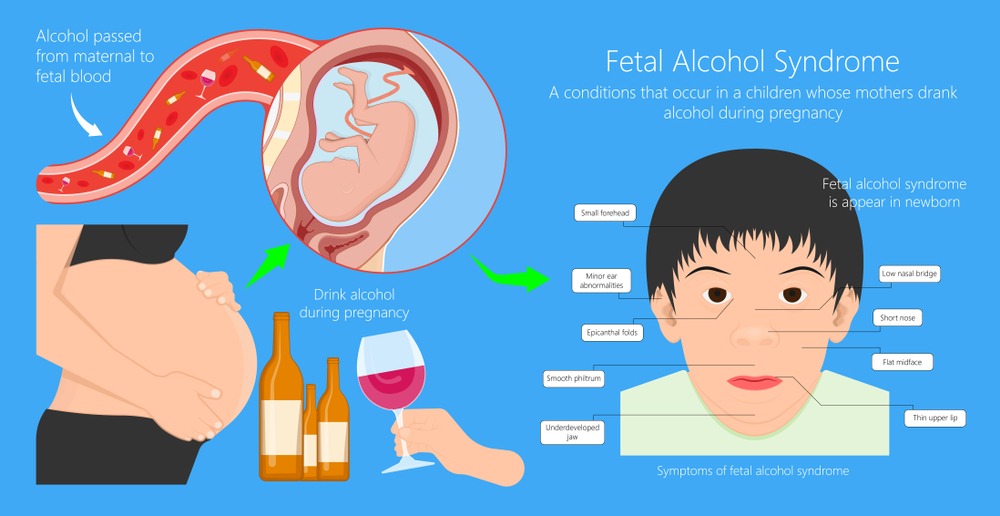Fetal Alcohol Syndrome
Introduction:
Fetal alcohol syndrome (FAS) is a complex and often misunderstood condition resulting from alcohol consumption during pregnancy. The purpose of this article is to explore the complex details of FAS, shed light on its harmful effects, and raise awareness of the importance of abstaining from alcohol during pregnancy.
What is Fetal Alcohol Syndrome?
Fetal alcohol syndrome, commonly known as FAS, refers to a range of physical, mental and developmental disorders caused by prenatal alcohol exposure. This happens when the mother drinks alcohol during pregnancy, which crosses the placenta and harms the developing fetus.
Physical effects of FAS:
FAS has various physical abnormalities that can be clearly observed, including facial deformities such as a smooth philtrum, a thin upper lip, and small eye holes.Other physical symptoms can include growth disorders, coordination problems and heart and kidney problems.These physical characteristics may vary from person to person, but are key indicators of FAS.
Cognitive and behavioral effects of FAS:
- FAS is not just limited to physical properties; It can also have profound effects on cognition and behavior.
- Children with FAS often suffer from learning difficulties, memory problems and difficulty paying attention and controlling their impulses.
- Behavioral problems such as hyperactivity, poor social skills, and impaired judgment are also commonly associated with FAS.
- These cognitive and behavioral challenges can persist into adulthood, necessitating comprehensive and early treatment of FAS.
Secondary disabilities:
- FAS can lead to secondary disabilities that further impact the individual’s overall quality of life.
- Mental health problems such as depression, anxiety and substance abuse are more common in people with FAS.
- People with FAS may also face difficulties in education, employment and independent living due to cognitive and behavioral limitations.
- Recognizing and treating this secondary disability is critical to providing comprehensive support to people with FAS.
The importance of prevention and diagnosis:
- Prevention is undoubtedly the best approach to fetal alcohol syndrome. Education and awareness campaigns play a key role in raising awareness of the risks of alcohol consumption during pregnancy. Women need to understand that no amount of alcohol is considered safe during this critical time.
- Early diagnosis of FAS is crucial to ensure rapid intervention and support. Physicians play a key role in identifying and evaluating the physical, cognitive, and behavioral symptoms associated with FAS. An accurate diagnosis helps develop appropriate treatment strategies, thereby improving outcomes for those affected by the disease.
Fetal Alcohol Syndrome Face:
Facial features of fetal alcohol syndrome:
Smooth Filter:
One of the most noticeable facial features in people with fetal alcohol syndrome is a smooth philtrum. The philtrum is a small groove that runs vertically between the nose and upper lip. Typically the depression has small ridges or depressions; However, in FAS, this area appears flat and lacks the characteristic structure commonly seen in healthy people.
Thin upper lip:
A typical feature of fetal alcohol syndrome is, in addition to the smooth philtrum, the thin upper lip. Instead of a fuller, more clearly defined upper lip, people with FAS often have a significantly thinner lip. This feature may contribute to the unique overall facial profile observed in individuals with this syndrome.
Brief cracking of the eyelid:
Another facial feature associated with fetal alcohol syndrome is the presence of short palpebral fissures.The opening between the upper and lower eyelids is called the palpebral fissure. In people with FAS, these openings tend to be shorter and narrower than average, which can make the eyes appear more almond-shaped.
Epicanthal folds:
Epicanthic folds are tiny horizontal folds of skin that can line the inner corner of the eye, causing the characteristic slanted appearance often seen in people with fetal alcohol syndrome. These wrinkles, which are generally more visible in individuals with FAS, may further contribute to the unique facial phenotype associated with the disease.
Flat nose bridge:
A flattened bridge of the nose is also common in people with fetal alcohol syndrome. Instead of the usual slight bump in the middle of the nose, people with FAS tend to have a flatter bridge of the nose. This feature can give the impression of a wider or flatter nose.
Micrognathia:
Micrognathia, or small, underdeveloped jaw, is an additional facial feature associated with fetal alcohol syndrome.This feature results in a markedly receding chin, which contributes to the distinct facial phenotype of FAS.
Implications and understanding:
Recognizing the unique facial features associated with fetal alcohol syndrome, such as: B. smooth philtrum, narrow upper lip, short palpebral fissures, epicanthal folds, flat nasal bridge and micrognathia, is crucial for the health of both professionals and society as a whole. In total. These indicators can help identify people who may have been affected by prenatal alcohol exposure, thereby helping to select appropriate interventions, supports and resources.
Note:
It is important to remember that although these facial features are highly suggestive of FAS, they are not definitive evidence of the disease. An accurate and complete diagnosis should include a thorough assessment by a doctor who considers other physical, cognitive and behavioral symptoms associated with fetal alcohol syndrome.
Fetal Alcohol Syndrome Symptoms:
Fetal Alcohol Syndrome (FAS) is a serious and lifelong condition that can occur in individuals who were exposed to alcohol in the womb during pregnancy. The severity of FAS can vary from person to person, but it is entirely preventable by avoiding alcohol during pregnancy. The symptoms and characteristics of Fetal Alcohol Syndrome can include:
Facial Dysmorphia:
- Smooth Philtrum (furrow between upper lip and nose)
- Thin upper lip
- Short eyelid creases (distance between inner and outer corners of the eyes)
Lack of Growth:
- Low birth weight
- Slower than normal growth before and after birth
problems of the central nervous system “CNS”:
- Intellectual disabilities
- Learning difficulties
- Poor memory and attention span
- Impaired reasoning and judgment
- Hyperactivity
- Impulsive
- Difficulty with abstract thinking
- Coordination and motor problems
Behavioral and Emotional Problems:
- Behavioral problems
- Social and emotional difficulties
- Impulsivity and hyperactivity
- Poor adaptation to changes or new situations
- Difficulties with consequences and cause-effect relationships
Organ defects:
- heart defects
- kidney problems
- Problems with hearing or seeing
- Joint or limb abnormalities
Note:
It is important to remember that fetal alcohol syndrome is a broad-spectrum disorder and not all people exposed to alcohol before birth will develop all symptoms. The term “fetal alcohol spectrum disorder” (FASD) is often used to describe a broader range of conditions caused by prenatal alcohol exposure, including FAS as the most severe form, as well as other conditions such as partial FAS and alcohol-related neurodevelopment. problems. problems. Birth Disorders (ARND) and Alcohol-Related Birth Defects
(ARBD).
Early diagnosis and intervention can help people with FASD improve their quality of life. If you suspect your child has FAS or FASD, it is important to seek medical evaluation and support from healthcare professionals who specialize in these conditions.In addition, prevention through alcohol abstinence during pregnancy is the most effective way to avoid FAS and FASD.
Conclusion:
Fetal alcohol syndrome is a complex and heartbreaking disease that can have lifelong consequences. In order to prevent the occurrence of FAS and provide those affected with the support they need, it is important to understand the pros and cons of FAS. By raising awareness and highlighting the importance of avoiding alcohol during pregnancy, we can work towards a better future where FAS is a thing of the past.Let us join forces to protect the well-being of our future generations.






Pingback: PMS - Journey Of Mother